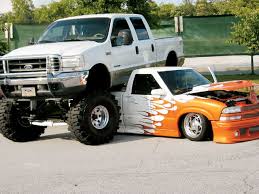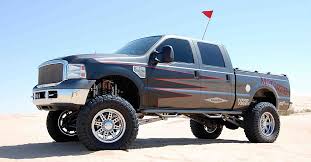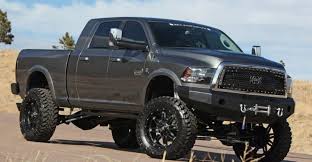Lifted trucks problems and solutions: The good, the bad, & the lifted
Lifted trucks are cool. Sky-high trucks are even cooler. Driving a lifted truck makes you feel like king of the road. You can see above all those road logs hauling soccer families, and you are able to see that sport compact that wrecked with the big rig, far up ahead, way before you even get into the mix. Lifted trucks draw attention from everyone on the road and act as giant billboards at local shows, putting that paintjob high up in the sky for everyone to see. Tall trucks command respect on the open highway, and most people will get out of your way once they feel the heat of your headlights on the backs of their necks. Lifted trucks are also functional. They allow people to traverse rough terrain safely and take the occupants to places far from the city to enjoy places of calm. These purpose-built rigs are freedom machines.
But with that freedom comes some drawbacks that need to be addressed in order for a lifted truck to work reliably and effectively as a daily driver. How high should a daily driver be? Is it practical to drive a 16-inch lifted truck on the street? And if you are going to lift to the extreme, what can you do to make your driving experience a more livable one? We’ll show you some of the common problems associated with lifted trucks and throw a few solutions your way so you can determine if living with a towering four-wheeled high-rise is for you.
BRAKING
Problem:
Brakes are often one of the most overlooked upgrades when installing larger tires. The big meats that inevitably find their way onto a truck after a lift will compromise your stock braking system. The increased leverage of the bigger tires, along with the heavier rotating mass, will quickly overwhelm the stock system, leading to overheating, premature pad and rotor wear, increased stopping distance, and minimal, if any, reserve braking power when loaded down or towing.
Solution:
Fortunately, for those of us who love big trucks, there are many companies out there offering big-brake upgrade kits. These kits are meant for use with larger-diameter wheels, and include larger and thicker drilled or slotted rotors, high-performance brake pads, and multi-piston calipers. Big-brake kits have excellent pedal feel, offer improved reserve braking, and are resistant to fade-causing heat buildup. Companies such as Baer, Brembo, Stainless Steel Brakes, and Stillen have the most popular truck applications covered. Many kits will include longer stainless steel-braided brake lines that will account for the extra height and suspension travel of the lift kit. Stainless steel lines also improve braking performance by deforming less under heavy braking, and they will be more resistant to rupture.
HANDLING
Problem:
Once the truck is up in the air and outfitted with those aggressive off-road lugs, you will notice deterioration of on-street handling. But, the pavement-shunning donuts are not the only cause of sloppy steering. The vehicle may exhibit bumpsteer, wandering, and slowly react to the driver’s inputs. All of the symptoms can be traced back to two types of issues: steering system overburdened by the wheels, and tires or improper steering geometry.
Solution:
Sometimes custom steering, including equal length setups, is required to cure a lifted truck’s steering ills. But, even on the most basic live-axle truck, it is important for the tie rod to be parallel to the axle and the trac bar and Panhard bar to be parallel to each other. Sometimes, an extended heavy-duty pitman arm can be used to keep good steering geometry. With really big tires, the stock steering system may be woefully inadequate, and steering assist, such as a hydraulic ram, may be necessary to help turn the meats. We also recommend religious maintenance of wheel bearings, and the addition of steering stabilizers to keep the frontend working properly. It is important to remember that your 3-1/2-ton rolling barge is no longer as capable in emergency avoidance maneuvers as it was when it was stock, and is by no means a sportscar. Your driving style should be tailored accordingly.
RIDE AND SUSPENSION
Problem:
Many first-time lifted truck owners don’t realize the ride penalty in going high. Not all kits are created equal, and a rough-riding rig can add to fatigue on long trips, make controlling the vehicle exhausting, and put wear on the truck itself. Generic suspension tuning and low-quality shocks can lead to driveability issues, such as vibrations, axle hop, and loss of suspension damping, which would lead to a more serious problem. While on the subject of suspension lifts, torsion bar twisting is an inexpensive method many people use to lift their truck, which may be OK for leveling, but it is not a true lift because it merely adjusts the level at which the truck sits in its suspension travel. Therefore, tires that rub at stock height will still rub with a torsion twist somewhere in the suspension travel. Also, the higher you go with a twist, the less down travel you will have, causing quirky handling, such as skipping across the road imperfections, rather that soaking them up. On 4×4 vehicles, this also causes an issue because you could over-extend a CV axle joint on a truck that has excessive compression, but limited droop.
Solution:
Spring and shock technology has come a long way in recent years. Reservoir shocks and coilover shocks once reserved for high-end race trucks are now within reach of many truck builders. These damping units are easily tuned, adjustable for ride height (coilovers), and are readily available from many high-end shock suppliers, such as Bilstein, Fox, King, and Sway-A-Way. Custom leaf springs, tuned to your vehicle and your needs, can easily be purchased from Atlas, Deaver, or National, just to name a few quality companies. Traction bars that locate the axle to the frame to reduce unwanted movement and axle hop are another way to tame the wildness in your suspension.

What to Look For When Buying Lifted Trucks Used
Lifted trucks can be a great purchase for anyone in East Texas looking to do a little off-roading, interested in a higher clearance for rough roads, or in love with the look of a truck that literally overshadows the competition. When buying a lifted truck used, though, it’s important to look for a few critical details that can have a huge impact on the performance and longevity of the vehicle.
Check the DriveShaft
First off, whether it’s a spacer or a suspension lift, it’s incredibly important to check the driveshaft and rear transmission shaft to make sure that the new angle created by the lift kit hasn’t already put too much wear and tear on the steel. In some cases, it can cause failure in the driveshaft by way of bending or breaking the boot, making it leak grease and put serious pressure on the ball bearings within. If the truck you find seems to have a driveshaft and transmission in good shape, then it’s a sign that the lift kit hasn’t put too much wear on the important internals and it will probably be a good buy.
Properly Fitted Tires
The second, and one that should be easy to check with a glance, is checking that the tires are the right size and that they aren’t too worn down. Normally, you would want to fit bigger tires on a lifted truck so that it’s better at handling rough roads and the new center of gravity of the vehicle. Lifting a truck can cause wear on the tires more quickly and large wheels are going to be more expensive, so it’s a good idea to make sure that the tires are going to last a while once you drive your new ride off the lot.

Vehicle History Report
On top of that, if you can, get the repair history! Dealers will keep records of the work they’ve done to a vehicle to make sure it’s ready for test drives and new buyers, and seeing the maintenance record can give you a good idea about what’s already been done to the truck as well as what you might need to look into or keep an eye out for in the future. Getting this should be a quick and simple part of buying any used car, and getting it for a lifted truck will be even more important.
Other Modifications or Upgrades
The last step should lead you into a few things you can learn about a lifted truck that should excite you! New or upgraded suspension is a fantastic thing to see in a lifted truck since a big part of having one is being able to go places and do things that a car (or even a standard truck) wouldn’t be able to handle. Along with that, things like steps, new tires, or engine upgrades can be really exciting to see on a vehicle that you intend to use for tough roads and rough terrain.
Used lifted trucks in Longview, TX can be great buys for off-roaders, dirt road drivers, and anyone looking to drive home in something no one can ignore. With a few quick checks, you can be sure that what you buy is the absolute best deal you can find.

Can I use Passenger Tires on my truck or do I have to use Light Truck tires?
Many people are interested in using Passenger Tires because they’re less expensive than Light Truck tires and generally offer a smoother ride.
But again, it’s very important to remember the intended purpose of your vehicle. If you have a ¾-ton or 1-ton pickup truck, you need Light Truck tires, because they offer the proper load carrying capacity for your heavy vehicle and its cargo. Passenger tires simply aren’t built to handle the weight of large vehicles, and using them for this application could potentially be dangerous.
Some people ask us the opposite question – if they can put LT tires on their small SUV or pickup. This can also cause some issues. LT tires are built for heavy vehicles, so their stiffness can give your vehicle a harsh ride, and since they require higher tire pressure, they can throw off your vehicle’s TPMS (Tire Pressure Monitoring System, a safety feature that alerts you to improper pressure in your tires). For these reasons, we don’t recommend using LT tires if your vehicle doesn’t require them.
Pre-Winter Truck Tire Inspection
Fleet managers should take care to perform a tire inspection on a regularly scheduled basis. However, extra measures should be taken ahead of the winter months to ensure your tires last through the season. In particular, ensure the tread depth of each tire is at least 4/32” for steer tires and 2/32” for other tires. The deeper your tires’ tread, the safer your drivers will be when on icy, snowy roads.
In addition to the tread depth, ensure your tires aren’t suffering from uneven wear and tear or have excessive punctures, tears, or other visible damage. Check the sidewalls and be sure that each tire is properly inflated. During colder weather, tire pressure will drop and increase the risk for a blowout. Every 10-degree drop in temperature will lower the pressure in your tires by 1 psi. Decrease your risk of a blowout by ensuring your tire pressure is at the optimal level before, during, and after each winter driving trip.
Commercial Truck Tire Rotation
To avoid uneven wear and tear and provide your tires with better long-term traction, be sure to have your commercial truck tires rotated ahead of the winter season. Doing this can also help reduce fuel costs for your fleet, especially when performed at regularly scheduled intervals. One way fleet managers can continue to reap the benefits of regularly scheduled tire rotations all year long is by partnering with a preventative tire maintenance provider.